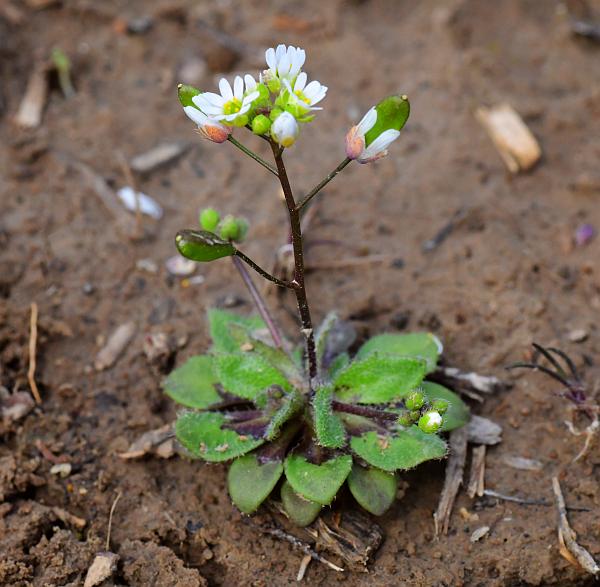Draba verna L.
Vernal Whitlow Grass

Introduced
CC = *
CW = 5
MOC = 45
© SRTurner
Draba verna L.Vernal Whitlow Grass | |
 |
Introduced CC = * CW = 5 MOC = 45 |
© SRTurner |
|
Family - Brassicaceae Habit - Taprooted annual forb.
Stems - Ascending to erect, single or multiple from the base (especially later in the season), to 20 cm, with forked pubescence near the base, glabrous along the inflorescence axis, scapose. Leaves - All in a basal rosette, 1-2 cm long, sessile, spatulate to oblanceolate, the margins entire or few-toothed, glabrous or sparsely hairy on the upper surface, hairy on the undersurface, the hairs forked and often with pustular bases.
Inflorescence - Terminal raceme, compact in flower, elongating in fruit. Pedicels 2-3 mm long in flower, to 1 cm in fruit, thin, mostly glabrous. Inflorescence axis mostly glabrous.
Flowers - Sepals 4, 1.0-2.0 mm long, green with whitish-scarious margins. Petals 4, 2.0-4.5 mm long, clawed, glabrous, white, deeply 2-lobed from the tip to about the middle. Stamens 6, erect. Ovary superior, green, glabrous. Styles absent or to 0.1 mm long.
Fruits - Ascending, flattened, 4.0-9.0 mm long, elliptoid to oblong, glabrous, many-seeded, 2-valved.
Flowering - February - April. Habitat - Grassy and rocky open places, lawns, fields, pastures, roadsides, cultivated fields, disturbed areas. Origin - Native to Eurasia. Lookalikes - Draba brachycarpa, D. reptans, Holosteum umbellatum Other info. - This tiny species is common throughout much of Missouri, particularly in the eastern half of the state. It also occurs in the eastern half and western third of the continental U.S., but is absent in much of the Great Plains. The plant is quite inconspicuous due to its diminutive stature. It is easily identified from its basal rosette of leaves, leafless stems, and divided petals. Photographs taken at Pilot Mountain State Park, NC., 3-9-03 (DETenaglia); also at Weldon Spring Conservation Area, St. Charles County, MO, 3-29-2013 and 3-15-2016; Shaw Nature Reserve, Franklin County, MO, 3-17-2015 and 3-23-2023; and near Labadie, Franklin County, MO, 3-17-2020 (SRTurner). |